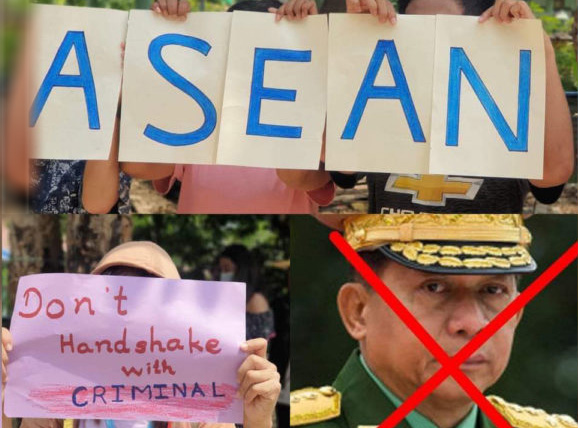The Association of Southeast Asian Nation called on the military junta to end the ongoing violence in Myanmar.
The call was ignored, and the brutality continues unabated.
ASEAN leaders invited junta leader Senior General Min Aung Hlaing, who grabbed power on Feb. 1, to a regional meeting in Jakarta on April 24.
Despite the fact that at least 750 civilians had already been killed by the junta’s forces, ASEAN leaders chose to meet with the junta’s leader rather than representatives of the civilian National Unity Government.
After the meeting, which was the junta leader’s first foreign trip since staging the coup, ASEAN states released a “five-point consensus,” including a call to stop the violence and exercise restraint as the top priority.
However, junta forces have continued to commit atrocities across the country with further killings, bombings, arrests and ongoing violence.
Killings
During a period of 11 days, from April 24 to May 4, junta forces killed at least 20 more people, effectively ignoring the plea by member states of ASEAN in Jakarta.
Even on the day of the summit, as the ASEAN leaders sat with the coup leader in Jakarta on April 24, his troops killed at least three civilians and continued brutal crackdowns on peaceful demonstrators demanding the restoration of democracy.
Among those killed during the meeting and in the following days were 22-year-old student Kaung Htet Naing, who was shot dead by plainclothes officers in Mandalay, and 22-year-old university student Thang Muan Lian, who was shot while he was riding his motorbike to guard a gasoline station in Chin State.

In other two cases, 32-year-old Ko Nyi Nyi Maung was shot in the stomach and died on the spot in Mandalay, when he tried to drive away in fright after he was stopped by soldiers, and Ko Kyaw Naing, 36, a villager from Sagaing Region’s Kani Township, died after being abducted and tortured.
In a bloodiest day after the meeting, the junta’s forces killed six people and wounded several others in Wetlet of Sagaing Reigon, Hsipaw and Naungcho of Shan State, Hpakant of Kachin State and Launglon of Tanintharyi Region.
In Hpakant Township of Kachin on May 2, more than 20 people were injured and one was killed when the junta forces fired live rounds and used hand grenades against protesters who were demanding democracy.
Airstrikes
Further violating the call to exercise restraint, the junta continued its bombing campaign with at least 21 airstrikes on Kachin and Karen states and Bago Region. Due to the airstrikes, some 30,000 local residents in the areas were forced to flee their homes.
A military air raid also killed at least three people, including a monk, after shells hit a monastery where displaced local residents were sheltering in a village in Moemauk of Kachin State on May 3.
While ASEAN called for constructive dialogue among all parties concerned in order to seek a peaceful solution, the junta continued to make mass arbitrary arrests.
Mass Arbitrary Arrests
From April 24 to May 4, it abducted more than 177 people including students, striking doctors, journalists and family members of pro-democracy activists.
After the regional meeting, Singapore Prime Minister Lee Hsien Loong told the media that “he [Myanmar junta leader] said he heard us.” However, in an announcement made two days after the meeting, the coup leader said he would only consider ASEAN leaders’ recommended steps once the country “stabilizes.”
Thomas H. Andrews, UN Special Rapporteur on the situation of human rights in Myanmar, said just as the command of his military demonstrates that there are no limits to his ruthlessness and brutality, his words demonstrate that there are no limits to his disregard for the truth nor his disrespect for ASEAN leaders.
Following the junta leader’s announcement, soldiers, police officers and plainclothes men were out in force. They launched extensive crackdowns in recent weeks, chasing after peaceful protesters at high speed in private vehicles or ramming into protesters. Youths suspected of being protesters were dragged away in private vehicles.
Video footage and photos by citizen journalists showed that detainees were beaten and forced to kneel down on the ground before being dragged away.
The junta is increasingly detaining the relatives of those who are in hiding. In one case, the 64-year-old mother of two activists was beaten at their home by junta forces in Yangon and detained.
Warrants
After the ASEAN meeting, the junta also issued a total of 290 new warrants against striking education staff and doctors who joined the civil disobedience movement (CDM) and students unions’ members.
The junta’s wanted list includes headmasters and headmistresses of government schools, education staff workers and teachers, superintendents, professors, doctors and students.
The CDM, the pro-democracy movement of Myanmar civil servants, was nominated for the Nobel Peace Prize for resisting the military coup in an inspiring and peaceful way.
“Now ASEAN and the world must decide what steps must be taken as an illegal junta continues to order more and more Myanmar people to be killed, injured or arbitrarily detained,” said the UN’s Thomas H. Andrews.
According to the Assistance Association for Political Prisoners (AAPP), which has tracked killings and detentions after the coup, at least 769 people have killed and 4,737 people were arrested, of them, 3,677 remained in detention as of May 4.
You may also like these stories:
Ethnic Chinese Woman Waiting for COVID-19 Jab Shot Dead by Myanmar Junta Troops
Myanmar Junta Faces UK Legal Action over Claims to Ambassadorial Home in London
Calls Grow to Cut Myanmar Junta’s External Financial Lifelines

















